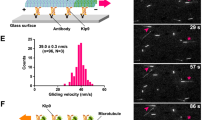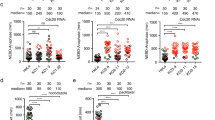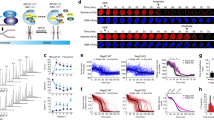Abstract
The Ran GTPase controls multiple cellular processes, including nuclear transport, mitotic checkpoints, spindle assembly and post-mitotic nuclear envelope reassembly1,2. Here we examine the mitotic function of Crm1, the Ran-GTP-binding nuclear export receptor for leucine-rich cargo (bearing nuclear export sequence) and Snurportin-1 (ref. 3). We find that Crm1 localizes to kinetochores, and that Crm1 ternary complex assembly is essential for Ran-GTP-dependent recruitment of Ran GTPase-activating protein 1 (Ran-GAP1) and Ran-binding protein 2 (Ran-BP2) to kinetochores. We further show that Crm1 inhibition by leptomycin B disrupts mitotic progression and chromosome segregation. Analysis of spindles within leptomycin B-treated cells shows that their centromeres were under increased tension. In leptomycin B-treated cells, centromeres frequently associated with continuous microtubule bundles that spanned the centromeres, indicating that their kinetochores do not maintain discrete end-on attachments to single kinetochore fibres. Similar spindle defects were observed in temperature-sensitive Ran pathway mutants (tsBN2 cells). Taken together, our findings demonstrate that Crm1 and Ran-GTP are essential for Ran-BP2/Ran-GAP1 recruitment to kinetochores, for definition of kinetochore fibres and for chromosome segregation at anaphase. Thus, Crm1 is a critical Ran-GTP effector for mitotic spindle assembly and function in somatic cells.
This is a preview of subscription content, access via your institution
Access options
Subscribe to this journal
Receive 12 print issues and online access
$209.00 per year
only $17.42 per issue
Buy this article
- Purchase on Springer Link
- Instant access to full article PDF
Prices may be subject to local taxes which are calculated during checkout




Similar content being viewed by others
References
Arnaoutov, A. & Dasso, M. The Ran GTPase regulates kinetochore function. Dev. Cell 5, 99–111 (2003).
Dasso, M. The Ran GTPase: theme and variations. Curr. Biol. 12, R502–R508 (2002).
Macara, I. G. Transport into and out of the nucleus. Microbiol. Mol. Biol. Rev. 65, 570–594 (2001).
Fornerod, M. et al. The human homologue of yeast CRM1 is in a dynamic subcomplex with CAN/Nup214 and a novel nuclear pore component Nup88. EMBO J. 16, 807–816 (1997).
Fornerod, M., Ohno, M., Yoshida, M. & Mattaj, I. W. CRM1 is an export receptor for leucine-rich nuclear export signals. Cell 90, 1051–1060 (1997).
Askjaer, P., Jensen, T. H., Nilsson, J., Englmeier, L. & Kjems, J. The specificity of the CRM1-Rev nuclear export signal interaction is mediated by RanGTP. J. Biol. Chem. 273, 33414–33422 (1998).
Nishitani, H. et al. Loss of RCC1, a nuclear DNA-binding protein, uncouples the completion of DNA replication from the activation of cdc2 protein kinase and mitosis. EMBO J. 10, 1555–1564 (1991).
Joseph, J., Tan, S. H., Karpova, T. S., McNally, J. G. & Dasso, M. SUMO-1 targets RanGAP1 to kinetochores and mitotic spindles. J. Cell Biol. 156, 595–602 (2002).
Joseph, J., Liu, S. T., Jablonski, S. A., Yen, T. J. & Dasso, M. The RanGAP1-RanBP2 complex is essential for microtubule-kinetochore interactions in vivo. Curr. Biol. 14, 611–617 (2004).
Kanda, T., Sullivan, K. F. & Wahl, G. M. Histone-GFP fusion protein enables sensitive analysis of chromosome dynamics in living mammalian cells. Curr. Biol. 8, 377–385 (1998).
Howell, B. J. et al. Spindle checkpoint protein dynamics at kinetochores in living cells. Curr. Biol. 14, 953–964 (2004).
Waters, J. C., Skibbens, R. V. & Salmon, E. D. Oscillating mitotic newt lung cell kinetochores are, on average, under tension and rarely push. J. Cell Sci. 109, 2823–2831 (1996).
Yao, X., Abrieu, A., Zheng, Y., Sullivan, K. F. & Cleveland, D. W. CENP-E forms a link between attachment of spindle microtubules to kinetochores and the mitotic checkpoint. Nature Cell Biol. 2, 484–491 (2000).
McDonald, K. L., O'Toole, E. T., Mastronarde, D. N. & McIntosh, J. R. Kinetochore microtubules in PTK cells. J. Cell Biol. 118, 369–383 (1992).
Mitchison, T. J. & Kirschner, M. W. Properties of the kinetochore in vitro. II. Microtubule capture and ATP-dependent translocation. J. Cell Biol. 101, 766–777 (1985).
Maiato, H., Rieder, C. L. & Khodjakov, A. Kinetochore-driven formation of kinetochore fibers contributes to spindle assembly during animal mitosis. J. Cell Biol. 167, 831–840 (2004).
Merdes, A. & De Mey, J. The mechanism of kinetochore-spindle attachment and polewards movement analyzed in PtK2 cells at the prophase-prometaphase transition. Eur. J. Cell Biol. 53, 313–325 (1990).
Rieder, C. L. & Alexander, S. P. Kinetochores are transported poleward along a single astral microtubule during chromosome attachment to the spindle in newt lung cells. J. Cell Biol. 110, 81–95 (1990).
Witt, P. L., Ris, H. & Borisy, G. G. Structure of kinetochore fibers: microtubule continuity and inter-microtubule bridges. Chromosoma 83, 523–540 (1981).
DeLuca, J. G. et al. Hec1 and nuf2 are core components of the kinetochore outer plate essential for organizing microtubule attachment sites. Mol. Biol. Cell 16, 519–531 (2005).
Salina, D., Enarson, P., Rattner, J. B. & Burke, B. Nup358 integrates nuclear envelope breakdown with kinetochore assembly. J. Cell Biol. 162, 991–1001 (2003).
Rieder, C. L. The structure of the cold-stable kinetochore fiber in metaphase PtK1 cells. Chromosoma 84, 145–158 (1981).
Cai, Y., Singh, B. B., Aslanukov, A., Zhao, H. & Ferreira, P. A. The docking of kinesins, KIF5B and KIF5C, to Ran-binding protein 2 (RanBP2) is mediated via a novel RanBP2 domain. J. Biol. Chem. 276, 41594–41602 (2001).
Ferreira, P. A., Yunfei, C., Schick, D. & Roepman, R. The cyclophilin-like domain mediates the association of Ran-binding protein 2 with subunits of the 19 S regulatory complex of the proteasome. J. Biol. Chem. 273, 24676–24682 (1998).
Pichler, A., Gast, A., Seeler, J. S., Dejean, A. & Melchior, F. The nucleoporin RanBP2 has SUMO1 E3 ligase activity. Cell 108, 109–120 (2002).
Wu, J., Matunis, M. J., Kraemer, D., Blobel, G. & Coutavas, E. Nup358, a cytoplasmically exposed nucleoporin with peptide repeats, Ran-GTP binding sites, zinc fingers, a cyclophilin A homologous domain, and a leucine-rich region. J. Biol. Chem. 270, 14209–14213 (1995).
Yaseen, N. R. & Blobel, G. Two distinct classes of Ran-binding sites on the nucleoporin Nup-358. Proc. Natl Acad. Sci. USA 96, 5516–5521 (1999).
Yokoyama, N. et al. A giant nucleopore protein that binds Ran/TC4. Nature 376, 184–188 (1995).
Nishi, K. et al. Leptomycin B targets a regulatory cascade of crm1, a fission yeast nuclear protein, involved in control of higher order chromosome structure and gene expression. J. Biol. Chem. 269, 6320–6324 (1994).
Saitoh, H., Cooke, C. A., Burgess, W. H., Earnshaw, W. C. & Dasso, M. Direct and indirect association of the small GTPase ran with nuclear pore proteins and soluble transport factors: studies in Xenopus laevis egg extracts. Mol. Biol. Cell 7, 1319–1334 (1996).
Acknowledgements
We thank E. D. Salmon and C. L. Rieder for insightful discussions. We thank E. D. Salmon, A. Khodjakov, I. Mattaj, and B. B. Quimby for critical comments on this manuscript. We thank D. Görlich for anti-Crm1 antibodies and Crm1 cDNA clones, and M. Yoshida for leptomycin B. We thank T. Anan and F. Ayaydin for help with the U2OSH2B–GFP and HeLaH2B–GFP cell lines. We thank the members of the Lippincott-Schwartz group for their assistance and for the use of the spinning disk confocal microscope.
Author information
Authors and Affiliations
Corresponding author
Ethics declarations
Competing interests
The authors declare no competing financial interests.
Supplementary information
Supplementary Information
Supplementary figures S1, S2, S3 and movie legends (PDF 251 kb)
Rights and permissions
About this article
Cite this article
Arnaoutov, A., Azuma, Y., Ribbeck, K. et al. Crm1 is a mitotic effector of Ran-GTP in somatic cells. Nat Cell Biol 7, 626–632 (2005). https://doi.org/10.1038/ncb1263
Published:
Issue Date:
DOI: https://doi.org/10.1038/ncb1263



